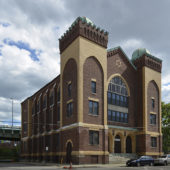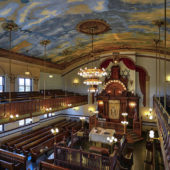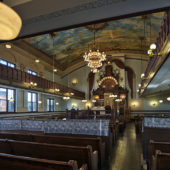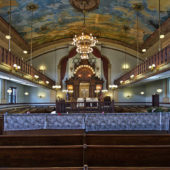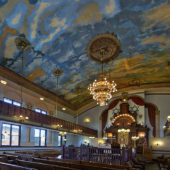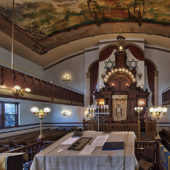Known as The Queen of Synagogues, it was the largest in New England at the time of its opening.
The Walnut Street Shul, formally named Congregation Agudath Shalom, was founded by Eastern European immigrants. From 1887 Jews gathered in the home of Monas Berlin to daven on Shabbosos and holidays. By 1901 the growing congregation had enough funds to purchase property at the corner of Walnut and Fourth streets. A new building on the site was almost completed when it was destroyed by a fire that also destroyed a third of the buildings in the city.
After the catastrophic fire the building was rebuilt from a design by non-Jewish architect Harry Dustin Joll. It was completed in 1909. The building, then known as the Queen of Synagogues, was believed to have been the largest shul in New England at that time. The magnificent carved Torah Ark (Aron Kodesh) is over 37 feet high. It was created by noted Boston-area cabinetmaker, Samuel Katz, who specialized in synagogue furniture. Made of solid oak, it has carvings of animals and symbols from the Torah.
The synagogue possesses a remarkable series of wall and ceiling frescoes painted by Jewish immigrant artists. The ceiling fresco shows a dramatic sky with a sunrise at the east end. Over the aron is a trompe-l’oeil-curtained niche supported by Corinthian columns and decorated with symbols from the Beis Hamikdash.
In the 1930s the Jewish population of Chelsea was large enough to support fourteen synagogues. Each of these synagogues tended to serve congregations whose origins were from specific geographic locations. Because Agudath Shalom’s congregation was to a large degree of Lithuanian origin, it was also known as the Litvishe shul. As happened with so many shuls established by immigrants, the congregation prospered and moved elsewhere in the metropolitan area. The Jewish population of Chelsea has continued to decline, yet Agudath Shalom has maintained a core congregation and has functioned continuously since its opening. A fund raising and restoration effort in the latter part of the 20th century enabled needed repairs bringing the building back to its former beauty. In 1993 Congregation Agudath Shalom was listed in the National Register of Historic Places.

